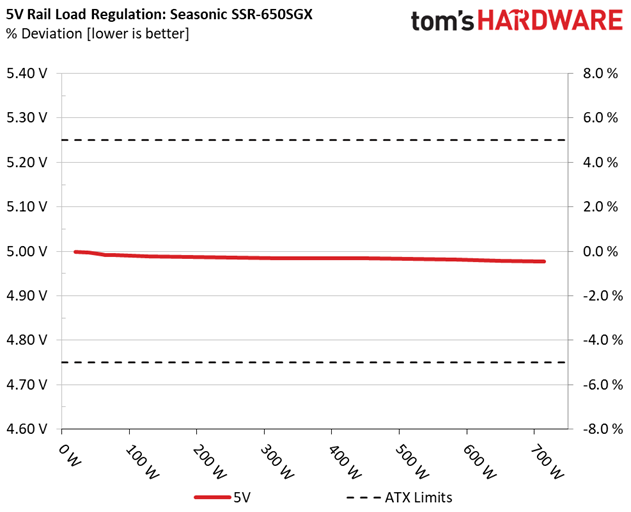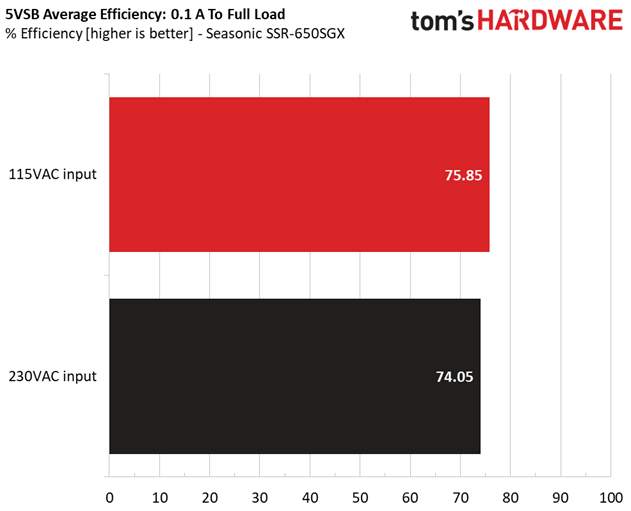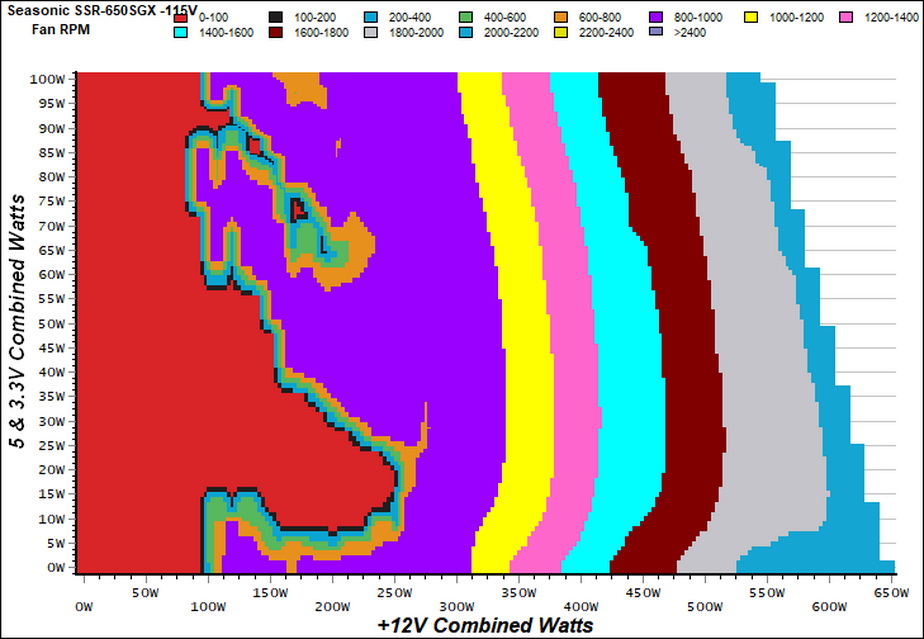Seasonic Focus SGX 650W SFX-L PSU Review: Reliable Power, Tiny Form Factor
Why you can trust Tom's Hardware
Load Regulation, Hold-Up Time, Inrush Current, Efficiency and Noise
To learn more about our PSU tests and methodology, please check out How We Test Power Supply Units.
Primary Rails And 5VSB Load Regulation
The following charts show the main rails' voltage values recorded between a range of 40W up to the PSU's maximum specified load, along with the deviation (in percent). Tight regulation is an important consideration every time we review a power supply because it facilitates constant voltage levels despite varying loads. Tight load regulation, among other factors, improves the system’s stability, especially under overclocked conditions and, at the same time, it applies less stress to the DC-DC converters that many system components utilize.








The load regulation is super tight on all rails, showing this platform's potential.
Hold-Up Time
Put simply, hold-up time is the amount of time that the system can continue to run without shutting down or rebooting during a power interruption.




It is good to see a longer than 17ms hold-up time in such a small, in dimensions, platform. The cherry on top is the power ok signal, which is accurate.
Inrush Current
Inrush current, or switch-on surge, refers to the maximum, instantaneous input current drawn by an electrical device when it is first turned on. A large enough inrush current can cause circuit breakers and fuses to trip. It can also damage switches, relays, and bridge rectifiers. As a result, the lower the inrush current of a PSU right as it is turned on, the better.


The inrush currents are kept low.
Get Tom's Hardware's best news and in-depth reviews, straight to your inbox.
10-110% Load Tests
These tests reveal the SSR-650SGX’s load regulation and efficiency levels under high ambient temperatures. They also show how the fan speed profile behaves under increased operating temperatures.
| Test # | 12V | 5V | 3.3V | 5VSB | DC/AC (Watts) | Efficiency | Fan Speed (RPM) | PSU Noise (dB[A]) | Temps (In/Out) | PF/AC Volts |
|---|---|---|---|---|---|---|---|---|---|---|
| 1 | 3.619A | 2.004A | 1.990A | 0.978A | 64.819 | 84.899% | 0 | <6.0 | 43.77°C | 0.960 |
| 11.944V | 4.992V | 3.312V | 5.112V | 76.348 | 39.04°C | 115.12V | ||||
| 2 | 8.243A | 3.007A | 2.989A | 1.176A | 129.342 | 88.998% | 932 | 19.7 | 39.53°C | 0.978 |
| 11.943V | 4.989V | 3.310V | 5.103V | 145.332 | 44.61°C | 115.12V | ||||
| 3 | 13.271A | 3.510A | 3.475A | 1.374A | 194.470 | 89.648% | 939 | 19.8 | 40.02°C | 0.984 |
| 11.941V | 4.987V | 3.309V | 5.094V | 216.925 | 45.78°C | 115.12V | ||||
| 4 | 18.296A | 4.012A | 3.990A | 1.573A | 259.673 | 89.863% | 1000 | 23.9 | 40.64°C | 0.987 |
| 11.941V | 4.986V | 3.308V | 5.085V | 288.966 | 47.23°C | 115.12V | ||||
| 5 | 22.988A | 5.016A | 4.986A | 1.774A | 324.974 | 89.544% | 1337 | 33.2 | 41.35°C | 0.989 |
| 11.940V | 4.985V | 3.307V | 5.076V | 362.923 | 48.68°C | 115.11V | ||||
| 6 | 27.614A | 6.020A | 5.989A | 1.974A | 389.487 | 89.087% | 1604 | 40.0 | 41.57°C | 0.989 |
| 11.939V | 4.984V | 3.306V | 5.066V | 437.199 | 49.83°C | 115.11V | ||||
| 7 | 32.310A | 7.023A | 6.986A | 2.176A | 454.816 | 88.442% | 1854 | 40.8 | 42.41°C | 0.989 |
| 11.938V | 4.984V | 3.306V | 5.056V | 514.251 | 51.10°C | 115.10V | ||||
| 8 | 37.001A | 8.029A | 7.987A | 2.379A | 520.128 | 87.713% | 2084 | 44.1 | 42.74°C | 0.991 |
| 11.938V | 4.983V | 3.305V | 5.046V | 592.987 | 52.26°C | 115.10V | ||||
| 9 | 42.096A | 8.534A | 8.475A | 2.381A | 585.051 | 87.005% | 2087 | 44.1 | 43.54°C | 0.992 |
| 11.938V | 4.981V | 3.304V | 5.040V | 672.430 | 53.71°C | 115.10V | ||||
| 10 | 46.925A | 9.039A | 8.992A | 2.987A | 649.891 | 86.013% | 2093 | 44.2 | 44.57°C | 0.992 |
| 11.938V | 4.979V | 3.302V | 5.023V | 755.570 | 55.41°C | 115.11V | ||||
| 11 | 52.359A | 9.043A | 8.995A | 2.991A | 714.713 | 85.193% | 2096 | 44.2 | 46.18°C | 0.993 |
| 11.937V | 4.977V | 3.301V | 5.016V | 838.932 | 57.53°C | 115.10V | ||||
| CL1 | 0.145A | 12.000A | 11.997A | 0.000A | 101.263 | 83.226% | 1339 | 33.2 | 41.55°C | 0.974 |
| 11.946V | 4.990V | 3.305V | 5.112V | 121.673 | 48.47°C | 115.13V | ||||
| CL2 | 54.015A | 1.002A | 0.999A | 1.000A | 658.197 | 86.754% | 2094 | 44.2 | 44.32°C | 0.992 |
| 11.938V | 4.983V | 3.310V | 5.067V | 758.692 | 55.17°C | 115.13V |
Up to the 40% load test the PSU's noise remains low, despite of the high ambient temperatures. With higher loads the fan has to operate at high speeds to cope with the thermal loads.
At high temperatures, the unit's efficiency meets the 80 PLUS Gold requirements only during the 20% load test. On the 50% test it is less than 0.5% away from the target, while at full load it is about 1% away. We should note though that the 80 PLUS organization conducts its efficiency measurements at much lower ambient (23°C ±5°C), so it is natural to get higher readings.
20-80W Load Tests
In the following tests, we measure the SSR-650SGX's efficiency at loads significantly lower than 10 percent of its maximum capacity (the lowest load the 80 PLUS standard measures). This is important for representing when a PC is idle, with power-saving features turned on.
| Test # | 12V | 5V | 3.3V | 5VSB | DC/AC (Watts) | Efficiency | Fan Speed (RPM) | PSU Noise (dB[A]) | PF/AC Volts |
|---|---|---|---|---|---|---|---|---|---|
| 1 | 1.210A | 0.500A | 0.481A | 0.195A | 19.546 | 71.154% | 0 | <6.0 | 0.857 |
| 11.942V | 4.999V | 3.318V | 5.131V | 27.470 | 115.12V | ||||
| 2 | 2.483A | 1.002A | 0.993A | 0.390A | 39.952 | 81.254% | 0 | <6.0 | 0.932 |
| 11.942V | 4.997V | 3.317V | 5.125V | 49.169 | 115.12V | ||||
| 3 | 3.688A | 1.503A | 1.476A | 0.586A | 59.442 | 85.068% | 0 | <6.0 | 0.958 |
| 11.943V | 4.993V | 3.314V | 5.120V | 69.876 | 115.12V | ||||
| 4 | 4.961A | 2.004A | 1.991A | 0.782A | 79.850 | 87.123% | 0 | <6.0 | 0.963 |
| 11.944V | 4.991V | 3.312V | 5.114V | 91.652 | 115.12V |
The PSU operates at passive mode in these tests.
Efficiency
Next, we plotted a chart showing the SSR-650SGX’s efficiency at low loads, and loads from 10 to 110 percent of its maximum-rated capacity. The higher a PSU’s efficiency the less energy goes wasted leading to a reduced carbon footprint, besides lower electricity bills.




The overall efficiency with normal loads should be a little higher, while with light loads the SSR-650SGX performs well.
5VSB Efficiency
| Test # | 5VSB | DC/AC (Watts) | Efficiency | PF/AC Volts |
|---|---|---|---|---|
| 1 | 0.100A | 0.514 | 73.851% | 0.110 |
| 5.134V | 0.696 | 115.11V | ||
| 2 | 0.250A | 1.283 | 76.233% | 0.224 |
| 5.131V | 1.683 | 115.11V | ||
| 3 | 0.550A | 2.820 | 77.387% | 0.337 |
| 5.126V | 3.644 | 115.11V | ||
| 4 | 1.000A | 5.120 | 77.365% | 0.405 |
| 5.119V | 6.618 | 115.11V | ||
| 5 | 1.500A | 7.667 | 77.711% | 0.439 |
| 5.111V | 9.866 | 115.11V | ||
| 6 | 3.000A | 15.235 | 75.940% | 0.482 |
| 5.078V | 20.062 | 115.11V |


The 5VSB rail has room for improvement, when it comes to efficiency.
Power Consumption In Idle And Standby
| Mode | 12V | 5V | 3.3V | 5VSB | Watts | PF/AC Volts |
|---|---|---|---|---|---|---|
| Idle | 11.934V | 4.998V | 3.317V | 5.135V | 6.741 | 0.493 |
| 115.1V | ||||||
| Standby | 0.046 | 0.007 | ||||
| 115.1V |


Fan RPM, Delta Temperature, And Output Noise
All results are obtained between an ambient temperature of 36°C (96.8°F) to 46°C (114.8°F).
The fan profile could be a bit smoother under higher loads. Nonetheless, Seasonic wanted to stay on the safe side given that this is a compact and over-populated platform, which has to outlive the extra-long 10-year warranty.
The following results were obtained at 30°C (86°F) to 32°C (89.6°F) ambient temperature.
The semi-passive mode doesn't last long. At up to 340W of load, the noise output remains low (below 30 dB[A]) while with higher than 430W loads the noise is within the 40-45 dB(A) range. As we already stated, the fan profile could be more balanced/relaxed under higher loads.
MORE: Best Power Supplies
MORE: How We Test Power Supplies
MORE: All Power Supply Content
Current page: Load Regulation, Hold-Up Time, Inrush Current, Efficiency and Noise
Prev Page Specifications and Part Analysis Next Page Protection Features, DC Power Sequencing, Cross-Load Tests and Infrared Images
Aris Mpitziopoulos is a contributing editor at Tom's Hardware, covering PSUs.






